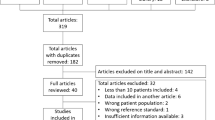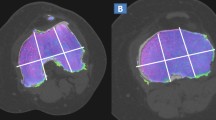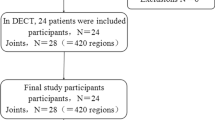Abstract
Objective
This study evaluated the ability of a custom dual-energy CT (DECT) post-processing material decomposition method to image bone marrow edema after acute knee injury. Using an independent validation cohort, the DECT method was compared to gold-standard, fluid-sensitive MRI. By including both quantitative voxel-by-voxel validation outcomes and semi-quantitative radiologist scoring-based assessment of diagnostic accuracy, we aimed to provide insight into the relationship between quantitative metrics and the clinical utility of imaging methods.
Materials and methods
Images from 35 participants with acute anterior cruciate ligament injuries were analyzed. DECT material composition was applied to identify bone marrow edema, and the DECT result was quantitatively compared to gold-standard, registered fluid-sensitive MRI on a per-voxel basis. In addition, two blinded readers rated edema presence in both DECT and fluid-sensitive MR images for evaluation of diagnostic accuracy.
Results
Semi-quantitative assessment indicated sensitivity of 0.67 and 0.74 for the two readers, respectively, at the tibia and 0.55 and 0.57 at the femur, and specificity of 0.87 and 0.89 for the two readers at the tibia and 0.58 and 0.89 at the femur. Quantitative assessment of edema segmentation accuracy demonstrated mean dice coefficients of 0.40 and 0.16 at the tibia and femur, respectively.
Conclusion
The custom post-processing-based DECT method showed similar diagnostic accuracy to a previous study that assessed edema associated with ligamentous knee injury using a CT manufacturer-provided, built-in edema imaging application. Quantitative outcome measures were more stringent than semi-quantitative scoring methods, accounting for the low mean dice coefficient scores.


Similar content being viewed by others
References
Kroker A, Besler BA, Bhatla JL, Shtil M, Salat P, Mohtadi N, et al. Longitudinal effects of acute anterior cruciate ligament tears on peri-articular bone in human knees within the first year of injury. J Orthop Res. 2019;37(11):2325–36.
Speer KP, Spritzer CE, Bassett FH 3rd, Feagin JA Jr, Garrett WE Jr. Osseous injury associated with acute tears of the anterior cruciate ligament. Am J Sports Med. 1992;20(4):382–9.
Mandalia V, Fogg AJ, Chari R, Murray J, Beale A, Henson JH. Bone bruising of the knee. Clin Radiol. 2005;60(6):627–36.
Eustace S, Keogh C, Blake M, Ward RJ, Oder PD, Dimasi M. MR imaging of bone oedema: mechanisms and interpretation. Clin Radiol. 2001;56(1):4–12.
Rangger C, Kathrein A, Freund MC, Klestil T, Kreczy A. Bone bruise of the knee: histology and cryosections in 5 cases. Acta Orthop Scand. 1998;69(3):291–4.
Booz C, Nöske J, Lenga L, Martin SS, Yel I, Eichler K, et al. Color-coded virtual non-calcium dual-energy CT for the depiction of bone marrow edema in patients with acute knee trauma: a multireader diagnostic accuracy study. Eur Radiol. 2020;30(1):141–50.
Pache G, Krauss B, Strohm P, Saueressig U, Blanke P, Bulla S, et al. Dual-energy CT virtual noncalcium technique: detecting posttraumatic bone marrow lesions–feasibility study. Radiology. 2010;256(2):617–24.
Björkman AS, Koskinen SK, Lindblom M, Persson A. Diagnostic accuracy of dual-energy CT for detection of bone marrow lesions in the subacutely injured knee with MRI as reference method. Acta Radiol. 2020;61(6):749–59.
de Bakker CMJ, Walker REA, Besler BA, Tse JJ, Manske SL, Martin CR, et al. A quantitative assessment of dual energy computed tomography-based material decomposition for imaging bone marrow edema associated with acute knee injury. Med Phys. 2021;48(4):1792–803.
Goodsitt MM, Rosenthal DI, Reinus WR, Coumas J. Two postprocessing CT techniques for determining the composition of trabecular bone. Invest Radiol. 1987;22(3):209–15.
Goodsitt MM, Shenoy A, Shen J, Howard D, Schipper MJ, Wilderman S, et al. Evaluation of dual energy quantitative CT for determining the spatial distributions of red marrow and bone for dosimetry in internal emitter radiation therapy. Med Phys. 2014;41(5):051901.
Krčah M, Székely G, Blanc R. Fully automatic and fast segmentation of the femur bone from 3D-CT images with no shape prior. In: 2011 IEEE international symposium on biomedical imaging: from nano to macro. New York City: IEEE; 2011. p. 2087–90.
Lang TF, Keyak JH, Heitz MW, Augat P, Lu Y, Mathur A, et al. Volumetric quantitative computed tomography of the proximal femur: precision and relation to bone strength. Bone. 1997;21(1):101–8.
Powell MJD. An efficient method for finding the minimum of a function of several variables without calculating derivatives. Comput J. 1964;7(2):155–62.
Mattes D, Haynor D, Vesselle H, Lewellyn T, Eubank W. Nonrigid multimodality image registration. San Diego: SPIE; 2001.
Anuta PE. Digital registration of multispectral video imagery. Optic Eng. 1969;7(6):706168.
Viola P, Wells WM III. Alignment by maximization of mutual information. Int J Comput Vision. 1997;24(2):137–54.
Astola J, Virtanen I. Entropy correlation coefficient, a measure of statistical dependence for categorized data. In: Proceedings of the University of Vaasa. Discus Pap. 1982. p. 44.
Maes F, Collignon A, Vandermeulen D, Marchal G, Suetens P. Multimodality image registration by maximization of mutual information. IEEE Trans Med Imaging. 1997;16(2):187–98.
Dice LR. Measures of the amount of ecologic association between species. Ecology. 1945;26(3):297–302.
McHugh ML. Interrater reliability: the kappa statistic. Biochem Med (Zagreb). 2012;22(3):276–82.
Filardo G, Andriolo L, di Laura FG, Napoli F, Zaffagnini S, Candrian C. Bone bruise in anterior cruciate ligament rupture entails a more severe joint damage affecting joint degenerative progression. Knee Surg Sports Traumatol Arthrosc. 2019;27(1):44–59.
Kim-Wang SY, Scribani MB, Whiteside MB, DeFrate LE, Lassiter TE, Wittstein JR. Distribution of bone contusion patterns in acute noncontact anterior cruciate ligament-torn knees. Am J Sports Med. 2021;49(2):404–9.
Viskontas DG, Giuffre BM, Duggal N, Graham D, Parker D, Coolican M. Bone bruises associated with ACL rupture: correlation with injury mechanism. Am J Sports Med. 2008;36(5):927–33.
Yoon KH, Yoo JH, Kim KI. Bone contusion and associated meniscal and medial collateral ligament injury in patients with anterior cruciate ligament rupture. J Bone Joint Surg Am. 2011;93(16):1510–8.
Cao JX, Wang YM, Kong XQ, Yang C, Wang P. Good interrater reliability of a new grading system in detecting traumatic bone marrow lesions in the knee by dual energy CT virtual non-calcium images. Eur J Radiol. 2015;84(6):1109–15.
Goodsitt MM, Christodoulou EG, Larson SC. Accuracies of the synthesized monochromatic CT numbers and effective atomic numbers obtained with a rapid kVp switching dual energy CT scanner. Med Phys. 2011;38(4):2222–32.
Jacobsen MC, Schellingerhout D, Wood CA, Tamm EP, Godoy MC, Sun J, et al. Intermanufacturer comparison of dual-energy CT iodine quantification and monochromatic attenuation: a phantom study. Radiology. 2018;287(1):224–34.
Matsumoto K, Jinzaki M, Tanami Y, Ueno A, Yamada M, Kuribayashi S. Virtual monochromatic spectral imaging with fast kilovoltage switching: improved image quality as compared with that obtained with conventional 120-kVp CT. Radiology. 2011;259(1):257–62.
Ueguchi T, Ogihara R, Yamada S. Accuracy of dual-energy virtual monochromatic CT numbers: comparison between the single-source projection-based and dual-source image-based methods. Acad Radiol. 2018;25(12):1632–9.
Rohlfing T, Brandt R, Menzel R, Maurer CR Jr. Evaluation of atlas selection strategies for atlas-based image segmentation with application to confocal microscopy images of bee brains. Neuroimage. 2004;21(4):1428–42.
Vogler JB 3rd, Murphy WA. Bone marrow imaging. Radiology. 1988;168(3):679–93.
Li X, Ma BC, Bolbos RI, Stahl R, Lozano J, Zuo J, et al. Quantitative assessment of bone marrow edema-like lesion and overlying cartilage in knees with osteoarthritis and anterior cruciate ligament tear using MR imaging and spectroscopic imaging at 3 Tesla. J Magn Reson Imaging. 2008;28(2):453–61.
Acknowledgements
The authors appreciate the work of Stephanie Kwong, Stacey Purdy, and Debbie Iampen for CT and MRI acquisition, and are grateful to Katrina Koger for participant recruitment and study coordination. The authors thank Peter Salat for contributing to the prospective evaluation of MRI studies to confirm injury diagnosis. Technical assistance from Bryce Besler and Justin Tse was also greatly appreciated. Finally, the authors thank all of our study participants, who volunteered their time for this study.
Funding
This study was funded by Canadian Institutes of Health Research (CIHR) grant number PJT-162189, and by an investigator-initiated grant through the National Basketball Association (NBA)/GE Healthcare Orthopedics and Sports Medicine Collaboration Program. CMJdB was supported by an Alberta Innovates Postgraduate Fellowship.
Author information
Authors and Affiliations
Corresponding author
Ethics declarations
Ethics approval
All procedures were approved by the University of Calgary Conjoint Health Research Ethics Board (REB19-1184), and were in accordance with the 1964 Helsinki declaration and its later amendments or comparable ethical standards.
Conflict of interest
This study was partially funded by an investigator-initiated grant from the National Basketball Association (NBA)/GE Healthcare Orthopedics and Sports Medicine Collaboration Program. Neither the NBA nor GE Healthcare was involved in the study design or analysis. The authors have no other conflicts of interest to disclose.
Additional information
Publisher’s note
Springer Nature remains neutral with regard to jurisdictional claims in published maps and institutional affiliations.
Supplementary Information
Below is the link to the electronic supplementary material.
Rights and permissions
About this article
Cite this article
de Bakker, C.M.J., Peedikayil, T., Walker, R.E.A. et al. Diagnostic accuracy of a dual-energy computed tomography-based post-processing method for imaging bone marrow edema following an acute ligamentous knee injury. Skeletal Radiol 51, 1817–1827 (2022). https://doi.org/10.1007/s00256-022-04023-7
Received:
Revised:
Accepted:
Published:
Issue Date:
DOI: https://doi.org/10.1007/s00256-022-04023-7




